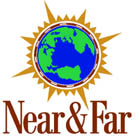
Cusco, located in southern Peru, is a city with perhaps the most beautiful views in the world. Surrounded by six mountains, some more than 15,000 ft high, it is the oldest city in the western hemisphere and the cradle of the Inca civilization. The altitude of the city is around 11,500 feet.
It is a town that unfolds for you gradually. At first glance, it seems big, a little chaotic and absolutley full of people. During the late 1980s - 1990s, thousands of rural Peruvians migrated to Cusco to protect themselves from the terrors of The Shining Path guerrillas. Former Peruvian President Alberto Fujimora is now being brought up on corruption charges but apparently he was effective in stamping out the Shining Path during his two terms in office. The city now has a population of about 300,000, triple the population it contained just 20 years ago.
Cusco was the capitol of the Inca empire. Remnants of the skillfully constructed walls are still evident throughout the city. Once the Spanish came along, they often destroyed the existing structures and built on top of the old Incan walls. Often, in the event of an earthquake, the Spanish structures would topple and the old Incan walls would remain standing.
Our hotel in Cusco was the Novatel. It is located within an old 16th century colonial estate. The original courtyard is now the lobby with a crystal clear glass ceiling for enjoying the nearby sun and nightly stars of the southern hemisphere. A never ending pot of coca tea is available in the lobby and was greatly appreciated. The rooms are nice and the service was excellent. It takes a little adjustment to deal with the assortment of local men, women and children who attach themselves to you once you exit the building. We were all charmed by the grandmother with the llama on a leash who made herself available for photos right outside the door. The short walk to the main square is lined with enticing shops. The cathedrals and other churches in the main square are bejeweled with much gold, silver, and local people deep in prayer.
We enjoyed delightful and energetic folkloric music and dance that evening, along with a nice dinner. I declined the guinea pig and llama meat, but others in our party were more daring. I don't think that I will ever forget that little guinea pig foot sticking out of the mouth of the man seated next to me at dinner! He stated, of course, that it "tasted like chicken".
The next morning we left on the motorcoach for the long ride across the altiplano to Puno and Lake Titicaca. It felt very other-worldly. Miles and miles of mountain vistas and occasional lone Andean women tending their sheep were the main attractions.
Puno itself is not a very attractive city, but it sits up against the hills surrounding Lake Titicaca.
It is the capital of the altiplano region, a dusty, commercial border town across
from Bolivia.
After checking into our hotel, we quickly left for a boat ride to visit the famous floating islands of Lake Titicaca. While it was cold and a little raining, the journey was very worth the effort. Second only to Machu Picchu, the floating islands were the highlight of the trip. The Uros people of the islands welcomed us with a lovely dance. We took a ride in one of their beautiful reed boats and of course, shopped their handicrafts. A lively female volleyball game was going on while we were there, complete with loudspeaker play-by-play. Words really cannot express the experience of visiting the floating islands. You will have to go yourself!
The next day, we journeyed by hydrofoil across Lake Titicaca to Bolivia. We visited the 3000 year old ruins of the Temple of the Moon. On the isle of the Moon is the Palace of the Virgins and the Temple of the Moon Mother, where the ancient Priestesses performed the Rite of the Dark Virgin of the Lake. One side of the temple has been reconstructed by archaeologists and one can definitely feel the power of the place.
Unfortunately, dramatic rain stopped us from visiting the nearby Temple of the Sun and so we made the journey back to Puno.
Many of us were feeling the effects of the high altitude and were ready to descend to the wild west town of Juliaca, where we caught a jet and returned to Lima. Last minute shopping at the artisans market completed our tour.
When people ask me how I enjoyed the tour,I respond that it was "challenging, but rewarding." I would not have missed the experience for the world. I feel simultaneously lighter and stronger, uplifted and grounded, wiser, braver, gentler, and happier. I can't wait to return someday!
SJC




